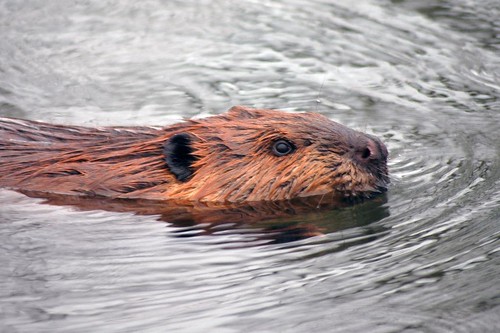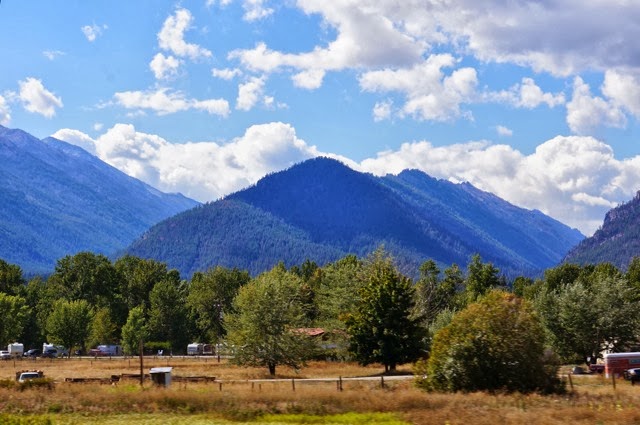We continue up the
Lolo Pass into Montana. The
Lewis and Clarke Expedition passed this way in September 1805 led by
Old Toby through deep snows. They returned through the pass the following June on their way homeward.
Today, we glide through this treacherous pass in modern comfort and good weather as opposed to the hardships that Lewis, Clarke and their men endured in 1805. They got lost and even after finding their way again, got bogged down in heavy snow. We stop to camp that night at
Lolo Hot Springs, a favorite stop by native tribes long before Lewis and Clarke passed this way.
 |
| Just over the summit at Lolo Pass |
|
 |
| Lolo Hot Springs |
|
|
Since it's a cool Sunday evening, we enjoy a hot meal and NFL Football in the
Hot Spring Bar with some of the locals and fellow travelers. The woman bar tender/waitress is really nice and lets us hang out as long as we want long after finishing dinner and our drinks.
 |
Bitterrroot River
alongside our camp |
|
 |
| Campsite at Lolo Hot Springs RV Park |
|
 |
| Morning |
|
The next morning we continue downhill through the
Bitterroot Mountains into the beautiful
Bitterroot Valley, home to
Missoula and the
Montana Grizzlies. The road leads us through a recent forest fire that raged through this region just a month ago. In fact, locals tell us the fire crews are still mopping up after this fierce blaze. We fuel up and buy groceries in Missoula, then head south through the valley where we pass many horse ranches and related businesses.
 |
| Recent burn from forest fire |
|
 |
| Tack shop for riding horses |
|
 |
| Classic Bitterroot Valley horse ranch |
|
As we travel south along the eastern slope of the Bitterrroots, we notice many steep canyons cutting into the mountains. From listening to the excellent audio book of
Undaunted Courage on a previous trip, we can see how Lewis and Clarke were stymied and frustrated by the many dead ends they encountered trying to get through the mountains. No wonder they had to rely on Old Toby to get through Lolo Pass.
We also learn a few things about the local Montana population now inhabiting the valley.
 |
| Log cabins of all sizes are common |
|
 |
| They are outspoken |
|
 |
| and they live in a beautiful place |
|
We stop at the
Bitterroot Ranger National Forest Station in Hamilton MT, where the rangers tell us where the campgrounds are located and which ones are best for us. TIP: it's well worth stopping in the local ranger station office when looking for National Forest Service campgrouds. The rangers are always very helpful. We end up at Jennning Campground on the East Fork of the Bitterroot River, where it's not only free of charge, but we're the only ones there.
 |
| Camped at Jennings |
|
 |
| Time to drink beer and watch the river flow |
|
 |
| Looks like a good place to fish |
|
The next morning dawns to a glorious day and we are off to an early start. We drive by
Lost Trail Hot Springs, but decide not to stop, although we admire their natural weed control system.
 |
| Long horn cattle relax in their pasture |
|
 |
| Out building at Lost Trail Hot Springs |
|
 |
| Natural weed control system takes a break |
|
The next stop is
Big Hole National Battlefield, the largest battle in the
Nez Perce War. If you have a chance to visit, the 20 minute video in the Visitors Center auditorium is excellent.
 |
| Entrance to Big Hole Battlefield, |
|
 |
| where we spot biker teddy bear mascot |
|
 |
| owned by a couple from Minnesota. |
|
 |
| Big Hole Battlefield - the Nez Perce village is located on the left |
|
|
|
 |
| Empty teepee poles mark the spot of the Nez Perce village |
The Nez Perce originally signed a treaty in 1855 with the US Government to maintain control of their ancestral lands for "as long as the waters flow and the grasses grow." However, in 1862 gold was discovered in Bannack MT bringing in a flood of white miners and settlers into Nez Perce terrority.
Giving into pressure from the settlers and miners, the US Government amended the Nez Perce treaty to reduce their territory. This new treaty was signed by the chiefs who were not affected by the new boundaries. However, those chiefs whose lands were impacted, refused to sign and furthermore refused to move to the now much smaller reservation in Idaho. For awhile they were ignored; however, in June - October 1877 US Calvary led by General Oliver O. Howard and Nelson A. Miles relentlessly pursued the non-treaty Nez Perce. After several skirmishes, the Nez Perce thought they had eluded the US Calvary as they settled into camp in the Big Hole Valley.
In a terrible pre-dawn attack the US Calvary killed over 90 Nez Perce, mostly women and children still sleeping in their teepees, while suffering only relatively minor casualties. The survivors fled northward hoping to join Sitting Bull in Canada. However, after leading his tired and starving peoples to within 40 miles of the border, Chief Joseph surrendered to General Howard giving this famous speech:
"Hear me, my chiefs! I am tired. My heart is sick and sad. From where the sun now stands I will fight no more forever."
In an 1877 editorial, the New York Times wrote:
"On our part, the war was in its origin and motive nothing short of a gigantic blunder and crime."
After exploring Big Hole, we continue driving through classic Montana ranches with wide pastures of Black Angus feeding in front of a mountain backdrop.
 |
| Black Angus cattle |
|
 |
| Hairpin Ranch |
|
 |
| Classic Montana scenary |
|
 |
| A driveway to a modern ranch in the Pioneer Valley |
|
|
|
We drive over Big Hole Pass and then turn off the main road onto the
Pioneer Mountain Scenic Byway (Montana Hwy 484) towards the small town of Polaris and
Elkhorn Hot Springs.
 |
| Byway entrance sign |
|
 |
| Wow - this really is a scenic byway |
|
 |
| We made it to Elkhorn! |
|
We claim a campsite at Grasshopper then return to the hot springs. About 10 head of free range cattle are milling about the parking lot as we arrive. Hey - this is Montana after all.
 |
| Half grown calf acts like s/he owns the place |
|
 |
| Then watches us from the safety of the spruces and Mommy |
|
|
 |
| Ahhh... this is more like it |
|
 |
| Peter gets a back massage |
|
 |
| A local dragonfly rests on the side of the pools |
|
After a nice soaking in the hot springs, we return to set up camp at Grasshopper NFS Campground.
 |
| Our Grasshopper camp |
|
 |
| Entrance to campground |
|
 |
| A small stream runs by our campsite |
|
Since the afternoon still has plenty of light left, I wander off to explore the area and to meet the campground hosts - Joe and Sally Johnson. They have an usual RV I'm curious about it.
Joe's off helping a friend put a new roof on a cabin, but Sally's at home. She explains that Joe used to work for Union Pacific as an diesel engine mechanic. He build their RV mostly out of discarded railroad siding and plywood. The truck/flatbed that carries their RV, Joe cobbled together from two different surplus military trucks (the engine and cab from a 1955 truck and the flatbed from a 1957). They have been campground hosts at Grasshopper for the last 15 years.
 |
| Joe and Sally's home away from home |
|
|
 |
| The 1955 cab and engine |
|
Sally is glad to have some company and is happy to show me around their RV, and even shows me photo albums of their family. Their RV is quite spacious inside. They have a queen sized bed over the cab, plus a large kitchen/dining room, a separate media room and a small bath room - all of which Joe built himself during the first year of his retirement.
 |
| Sally at the front door |
|
 |
| Kitchen/dinning room |
|
 |
| Ohh - a real pantry! |
|
 |
| Happy face on toilet |
|
Most of the time, I'm skeptical about people boasting about their accomplishments, but Joe deserves it! What he has built out of discards is truly amazing - an unmatched pioneer recycle artist.
It's a lovely evening, so we enjoy a campfire after dinner to watch the stars and UFO's streak across the night sky.





























































































